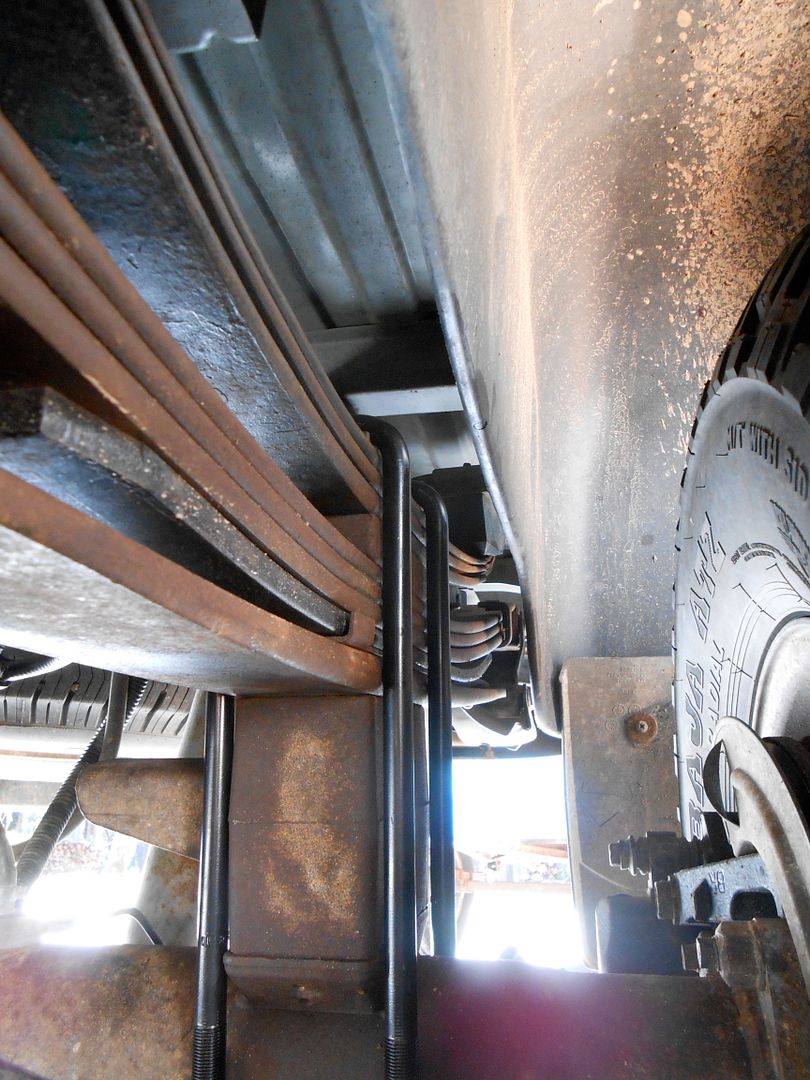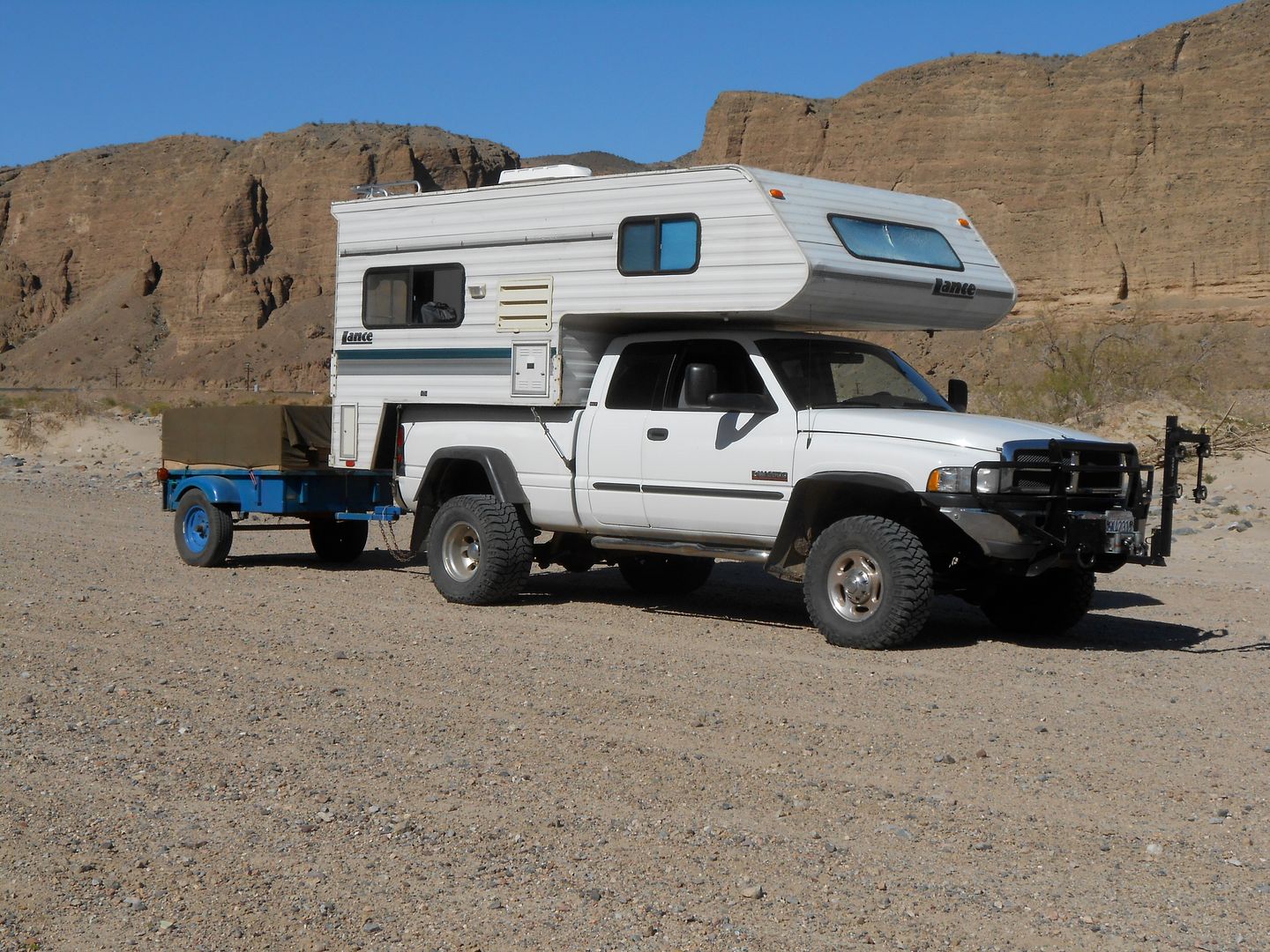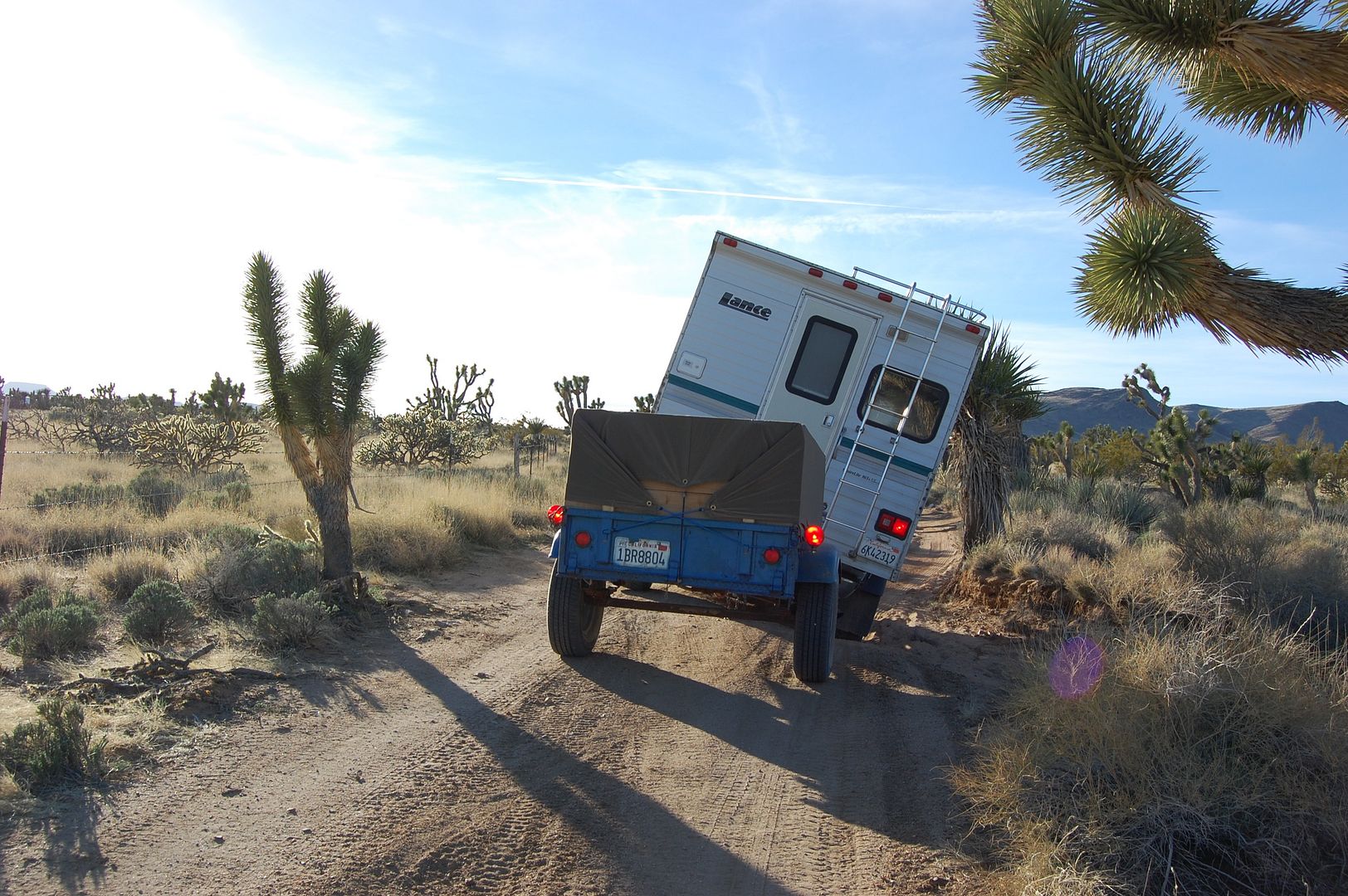- Good Sam Community
- Everything RV
- Campground 101
- Re: Ideas for Carrying and xfer of water to fresh ...
- Subscribe to RSS Feed
- Mark Topic as New
- Mark Topic as Read
- Float this Topic for Current User
- Bookmark
- Subscribe
- Mute
- Printer Friendly Page
Ideas for Carrying and xfer of water to fresh tank
- Mark as New
- Bookmark
- Subscribe
- Mute
- Subscribe to RSS Feed
- Permalink
- Report Inappropriate Content
Jul-01-2013 12:43 PM
I have a 30 gallon plastic barrel and I was thinking of filling it and hauling it back to camp. Anyone use an electric pump for filling their r v fresh water tank? I am dealing now with Rheumatoid Arthritis and lifting the water jugs isn't that easy anymore. (I know, more trips less water at a time in the jug.)
6-spd manual 3.73 axle
Gemtop
Rhinoliner
Pullrite hch, Prodigy Bk. Ctl.
Jayco 25RKS
Randy & Colleen
- Labels:
-
Boondocking
-
Dry Camping
-
Public Lands
- Mark as New
- Bookmark
- Subscribe
- Mute
- Subscribe to RSS Feed
- Permalink
- Report Inappropriate Content
Jun-13-2014 10:11 AM
- Mark as New
- Bookmark
- Subscribe
- Mute
- Subscribe to RSS Feed
- Permalink
- Report Inappropriate Content
Jun-10-2014 08:42 PM
During drycamping (boondocks or otherwise): For the toilet ... when it's brown -> flush it down, when it's yellow -> let it mellow.
Using these and other conservation techniques, we can stretch to about 5 days of drycamping based on our built-in tank freshwater capacity. We can go longer based on our grey/black combined tank capacities ... hence my comments earlier in this thread about built-in RV fresh water capacities being equal to, or greater than, combined grey/black tank capacities. The reason I say "equal to, or greater than" is to cover freshwater losses other than into the grey and black tanks - such as losses through body sweat, cooking evaporation, humidifier usage, etc..
FWIW, we are in the 3rd or 4th year of a California drought that has become serious enough such that both the springs and the well supplying our residence are way down from their historical fresh water deliver rates ... the camping fresh water conservation methods I mention above are now almost as fully enforced when we're living in our residence.
You can't have too much freshwater along in your RV during drycamping treks - only more than you can find room for, or more than your RV's chassis can carry weight-wise.
- Mark as New
- Bookmark
- Subscribe
- Mute
- Subscribe to RSS Feed
- Permalink
- Report Inappropriate Content
Jun-10-2014 03:12 PM
Do you turn water on to wash your hands?
Do you turn water on to flush your toilet?
By not doing so, you can save much water and eliminate water going into the Black and Grey water tank. Thus eliminating more reasons to find a dump station location. By using conservation methods you save water. Many believe they are conserving potable water but learn they can do even more.
b
09 Lance 1191
1,560wSolar~10-6vGC2-1,160AmpH~Tri-Star-Two(2)60/MPPT~Xantrex 2000W
300wSolar~2-6vAGM-300AmpH~Tri-Star45/MPPT~Xantrex 1500W
16 BMW R1200GSW Adventure
16 KTM 500 EXC
06 Honda CRF450X
09 Haulmark Trlr
- Mark as New
- Bookmark
- Subscribe
- Mute
- Subscribe to RSS Feed
- Permalink
- Report Inappropriate Content
Jun-10-2014 11:18 AM
It seems logical to me that RV manufacturers should "always" design-in freshwater capacity to AT LEAST equal black water capacity plus grey water capacity -> especially since grey water tanks can be off-loaded into black water tanks to, for all practical purposes, combine their capacities. i.e. Our combined grey plus black water capacity is around 68 gallons. I sure would like to carry at least 68 built-in gallons of freshwater along. Our chassis can easily carry that much more weight and we'd never see it in our gas mileage.
- Mark as New
- Bookmark
- Subscribe
- Mute
- Subscribe to RSS Feed
- Permalink
- Report Inappropriate Content
Jun-10-2014 12:03 AM
pnichols wrote:
I'm no TC'er ... but it seems like for treks like that in the photos above one would want an over-kill chassis so weight was - for all practical purposes in at least dry conditions - not an issue.
Wouldn't a ton truck chassis increase water carrying capacity significantly even though camper weight didn't require a ton chassis per se ... assuming one could find low-down places to carry the water on the rig? Perhaps long, shallow-depth water tanks could be mounted up in between the frame members on either side of the driveshaft? I've read of one Class C owner who was able to increase water carrying capacity to 150 gallons with external tanks mounted up and under their small motorhome in this way. Of course in off-road conditions plastic potable water auxiliary tanks mounted up and under this way should have aluminum or steel protection plates on their bottom sides.
Our current built-in water capacity is only around 45 gallons carried in a concealed tank that's mounted right down on the floor in the coach interior environment. However, I'd prefer built-in water capacity of at least double that amount, but as of yet have not added the auxiliary tank(s) for it.
Here's a link to various size RV water tanks for building in - some of the 25 gallon to 35 gallon configurations look very interesting:
http://www.plastic-mart.com/category/33/rv-water-tanks
When I first started putting my project together, back in 2008, and my goal was to provide solutions to many of the critical needs of long term boondocking, without replenishing. One of the critical factors, was water. Picking the right truck camper, with substantial capacity for potable water was important. With this, I added two additional potable tanks. When I began my ongoing adventure, I had the capacity of 190+ gals of potable water. While my truck was capable of carrying all of the weight of my camper/supplies/personal belongings, I realized that with simple conservation techniques I am able to forgo filling the two auxiliary tanks and still last for 6 to 8 weeks before replenishing supplies and fuel. So, I have only filled my two auxiliary tanks completely, twice. In the years I have been on the road, I have learned that water availability is much greater than I had ever imagined and large quantities of grey water is an important consideration in disposal. So, I just do with less and conserve more. My methods are considered extreme, by some, but many follow my tips in how to conserve too. Rather than put more emphasis on how to carry more, I would revisit in how one can conserve more.
b
09 Lance 1191
1,560wSolar~10-6vGC2-1,160AmpH~Tri-Star-Two(2)60/MPPT~Xantrex 2000W
300wSolar~2-6vAGM-300AmpH~Tri-Star45/MPPT~Xantrex 1500W
16 BMW R1200GSW Adventure
16 KTM 500 EXC
06 Honda CRF450X
09 Haulmark Trlr
- Mark as New
- Bookmark
- Subscribe
- Mute
- Subscribe to RSS Feed
- Permalink
- Report Inappropriate Content
Jun-09-2014 11:22 PM
I always figured the 4XXX series of any brand was kindof their "ton-and-a-half" chassis, coming at in around the 14K+ lb. range on capacity. I consider the 5XXX series as "two-ton".
My E450 has around 2200 more lbs. capacity that I'm currently not using. Although this can be used for a lot of added water, I wanted too much RV chassis for the job for reasons other than weight carrying: Added transmission cooling capacity for improved transmission life, larger brake swept area for added downhill safety and longer times between brake jobs, and a lower rear differential ratio for less transmission slippage when crawling along desert roads while rockhounding. For my use, the E450 also has thicker chassis steel for added stiffness with whatever weights I do carry, which helps keep the coach platform in a plane on rutted roads.
Regarding side-by-side duals -> they have their good points and bad points. One of their good points is better flotation in soft conditions due to a smaller pounds per square inch surface loading ... which makes them "sink in" less for any given weight on the rear axle.
FWIW, I once had a heavy duty 1965 F250 "3/4 ton" Ford PU with 15 leaf springs in each rear position. I brought home (safely) uphill all the way for miles 6000 lbs., by actual scale weight, of drain rock from the quarry in the box of that truck. No diesel required either ... the long-throw 390 thumper did the job with ease.
- Mark as New
- Bookmark
- Subscribe
- Mute
- Subscribe to RSS Feed
- Permalink
- Report Inappropriate Content
Jun-09-2014 10:07 PM
I have an overkill chassis. A one ton and a 3/4 ton Dodge of that era have exactly the same frame, brakes, drivetrain, body. The dualie rr axle is slightly narrower than the SRW rr axle because of the hub extensions and the wheel backspacing. My 2500 has the Dana 80/35 spline axle they use in MoHo's. I have spent a lot of time upgrading the suspension to handle a lot of extra weight. This is my 8 leaf setup on the rr axle: an overload bottom spring, a 3" lift spring, the stock 3 leaf main pack, a 3-leaf secondary pack above with Stable Loads to make them come into play sooner:

I have loaded the pickup (without the TC) up with 5000 pounds of crushed rock with no ill effects. Of course i didn't drive to New York this way, but you get a feel if it is overloaded. It wasn't.
Weight is always a concern no matter how hefty your rig is. My point was to only carry what you 'think' you will need and a little more. I can load your E-450 up enough to make it cry uncle, but to what end? By the way, an F-450 is not a 1-1/2 ton. An F-550 or with certain acoutrements or an F-650 would be a 1-1/2 ton. I have a Clark 280VO transmission in my garage that came out of an F-650. Besides, the 1/2 ton, 3/4 ton, 1 ton, 1-1/4 ton monikers are now obsolete, and have been replaced with 1500, 2500, 3500, 4500 and 5500.
I think this boils down to your perspective and how much water you use. We are on the minimalist side.
regards, as always, jefe
- Mark as New
- Bookmark
- Subscribe
- Mute
- Subscribe to RSS Feed
- Permalink
- Report Inappropriate Content
Jun-09-2014 09:46 AM
Wouldn't a ton truck chassis increase water carrying capacity significantly even though camper weight didn't require a ton chassis per se ... assuming one could find low-down places to carry the water on the rig? Perhaps long, shallow-depth water tanks could be mounted up in between the frame members on either side of the driveshaft? I've read of one Class C owner who was able to increase water carrying capacity to 150 gallons with external tanks mounted up and under their small motorhome in this way. Of course in off-road conditions plastic potable water auxiliary tanks mounted up and under this way should have aluminum or steel protection plates on their bottom sides.
We have a small Class C motorhome we take boondock camping in the desert (rockhounding) that we bought new specifically because it was built on a ton-and-a-half chassis not actually required for normally expected camping weights. As a consequence we can load it up with no thought given to the added weight, so we can easily carry many additional gallons of water without even feeling it. Our current built-in water capacity is only around 45 gallons carried in a concealed tank that's mounted right down on the floor in the coach interior environment. However, I'd prefer built-in water capacity of at least double that amount, but as of yet have not added the auxiliary tank(s) for it.
Here's a link to various size RV water tanks for building in - some of the 25 gallon to 35 gallon configurations look very interesting:
http://www.plastic-mart.com/category/33/rv-water-tanks
- Mark as New
- Bookmark
- Subscribe
- Mute
- Subscribe to RSS Feed
- Permalink
- Report Inappropriate Content
Jun-06-2014 10:07 AM
As an XTC'er, with a small, hardside truck camper, I have a minimalist water setup that is expandable according to need.
The Lance Lite 165-s comes with an 18 gallon fresh water tank. I know that sounds pitifully small, but remember, you have to carry this stuff, and @ 8.3 pounds per gallon that adds up quickly. I'm in the same, but smaller yet camp as is Bryan (BKA).
6-one gallon, H.D. Nalgene drinking/cooking water jugs, inside a low down cabinet on the floor of the TC.
24, or more 16 oz. commercial waters stored behind the little doors that open ahead of the wheel wells of the pickup.
To this basic water carry, I can add 4-2-1/2 gallon low slung plastic water jugs.
If more water is needed, I must pull Little Blue Bradley along with up to 4, 5 gallon, low slung plastic 'jerry cans' for water.
For a really remote water carry, I have a 30 gallon ex-pickle plastic barrel that would have to go in the jeep trailer too. Why? Weight. The measly 30 gallons weighs 250 pounds! Plus the barrel.There is no way anyone with arthritis could pick this up. It takes two very burley boys to even move this thing. A small, driver driven pinion plastic water pump is good enough for transfer. Notice I made most of the add-on water supply in small containers. Why? With the bouncing and shock loading these containers get on say, the Mojave Road there is less weight in the container to shock load or split the container. Also, the cyclists filled their camel backs via the little rear most fresh water spigot on the TC, so was refilling the main water tank with those easy to lift 2.5. gallon cans every day. Here is little Blue Bradley55 and TC on the Mojave Road with 20 extra gallons of water in the trailer. As i was one of the SAG wagons for this trip, It was enough water for seven people ( 3 on bicycles, 2 on motorcycles, 2 driving hard side truck campers) for the 3 day, 146 mile two-track traverse. But, just enough. It is hard to believe the bike people drank that much water, about 3 gallons a day on the trail, constantly refilling their camelbacks.


So, keep the containers small if you do any off-road stuff or have any physical frailty. Carry only what you think you will need plus a little more, but not the max all the time.
regards, as always, jefe
- Mark as New
- Bookmark
- Subscribe
- Mute
- Subscribe to RSS Feed
- Permalink
- Report Inappropriate Content
Jun-05-2014 06:21 AM
2013 Cedar Creek 38FL - Front Living, Trail Air
2011 Dodge RAM 3500 6.7 CTD DRW CC LB
Our Website - "A Work in Progress"
- Mark as New
- Bookmark
- Subscribe
- Mute
- Subscribe to RSS Feed
- Permalink
- Report Inappropriate Content
May-23-2014 10:09 AM
If you want to get real fancy, pick up a WATERBOY. I've bought one last year and it works awesome. Pricey, but good.
WATERBOY
2013 Forest River 3001W Windjammer
Equilizer Hitch
Honda EU2000
"I have this plan to live forever; so far my plan is working"
- Mark as New
- Bookmark
- Subscribe
- Mute
- Subscribe to RSS Feed
- Permalink
- Report Inappropriate Content
May-19-2014 08:21 PM
2014 BoonHauler 3614
- Mark as New
- Bookmark
- Subscribe
- Mute
- Subscribe to RSS Feed
- Permalink
- Report Inappropriate Content
May-19-2014 01:02 PM
I hook a small two foot hose from the tank to the pump and a longer hose from the pump to the trailer water tank. Plug the pump into the receptacle in the bed of my truck and I have water moving.
Lots of tanks at Tractor Supply and they are not expensive.
2009 WW HKD
A few toys...
- Mark as New
- Bookmark
- Subscribe
- Mute
- Subscribe to RSS Feed
- Permalink
- Report Inappropriate Content
May-19-2014 12:01 PM
rx2tee wrote:Don't use this pump for Potable Water tanks. Right on the side of the pump it shows this is a Cast Iron Pump. Home Depot and others have Potable Water Pumps, this is not one. This pump is designed for use with ground water, that is why it is called a Sump Pump. Seals, lubricants used in the manufacture of this item are not compatible with use with drinking water.
wkswenson
Is this the pump your are referring to?
Wayne Pump at Home Depot
Thanks to everyone for the ideas.
Use at your own risk. Carrying a simple RV type pump is often cheaper, safer and will pump at adequate rates.
b
09 Lance 1191
1,560wSolar~10-6vGC2-1,160AmpH~Tri-Star-Two(2)60/MPPT~Xantrex 2000W
300wSolar~2-6vAGM-300AmpH~Tri-Star45/MPPT~Xantrex 1500W
16 BMW R1200GSW Adventure
16 KTM 500 EXC
06 Honda CRF450X
09 Haulmark Trlr
- Just bought a used rv from private seller in DIY Maintenance
- How to drain fresh water tank? in DIY Maintenance
- Help w/ hot water heater in DIY Maintenance
- Filling and emptying water tanks at camp in DIY Maintenance
- One of my favorite weekend spots: Fort Bragg, CA on the Mendocino Coast in Campground 101





